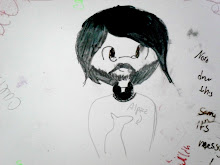So, this week´s mission at Mate Mondays: cultura popular. Music on the radio, food, T.V...all the daily things I´ve become so used to over the past seven-and-a-half months in Montevideo. Today´s topic: music.
I´ve talked quite a bit about murga, but not so much about the sort of stuff that gets radio play. One of the biggest bands in Uruguay right now is La Vela Puerca. They´re rock nacional (i.e. they´re Uruguayan), marked by catchy melodies and smarter-than-your-average-pop-song lyrics. My personal favorite is this one (http://www.youtube.com/watch?v=Wyg2E3iMVvM), Zafar...we´ve sung it with the kids at La Obra. For the non-Spanish speakers reading this blog, the lyrics deal with life in the city, with all its pollution and problems, and the need to get away. Another well-known and liked song by La Vela Puerca (again, I know this one originally from music time at La Obra) is El Viejo (http://www.youtube.com/watch?v=WMmqBjFIUIQ&feature=related).
La Vuela Puerca is far from the only home-brewed act, however. El Cuarteto de Nos, another rock band, has gotten a lot of radio play for their song Yendo A La Casa de Damián (note the incredibly heavy usage of words derived from English in the song!) (http://www.youtube.com/watch?v=LKbcMsd7TsY); they even performed at the Latin Grammies this year, as did Jorge Drexler, another Uruguayan. Jorge Drexler´s style is rather more laid-back than El Cuarteto de Nos; if El Cuarteto de Nos is music I associate with a wild party, then Jorge Drexler is what I associate with something like hanging out in Parque Rodó, or a good chat with a friend...check out Todo Se Transforma (http://www.youtube.com/watch?v=oCjpqx3cXs0) and Milonga de Moro Judío (http://www.youtube.com/watch?v=R3lb7Vx2yVI&feature=related) for examples of a folkier, lighter sounding Uruguayan sound.
Also incredibly popular is a style of music with Colombian origins called...cumbia. It´s dominant feature is it´s very distinct rhythm - chick-a-chick, chick-a-chick, chick-a-chick, chick-a-chick. You may have heard it, or at least of it, if you´re from south Texas - cumbia is enormous in the whole of Latin America, it seems. It is truly omnipresent in South America...I have heard cumbia in three very different nations, in different regions of those countries, and being listened to by a mix of people. It tends to be associated, at least in Argentina and Uruguay, with the lower socioeconomic class, but I´ve seen plenty of middle-to-upper-class people listening to songs like El Bombón Asesino (http://www.youtube.com/watch?v=M_f9Vduko1U). Increasingly popular is cumbia villera, which is cumbia blended with some hip-hop and rap influences and performed with more contemporary instruments; its origins are associated with the villas miserias (slums) outside of Buenos Aires. A particularly popular artist in this genre is El Polaco (http://www.youtube.com/watch?v=hjd9472nf4g).
Of course, not all the music played here is local, or from Latin America. Eighties music is HUGE right now; I have lost count of how many times I´ve heard Come On Eileen, Eye of the Tiger, The Final Countdown, Like A Virgin, and many other classics of the decade on the bus. Plenty of contemporary rock/pop from the English-speaking world makes its way down here, too - I´ve heard Avril Lavigne, Green Day, and Gwen Stefani blaring from the radio of the 328 on the way to La Obra, too. Most classic rock gets plenty of radio play, and even some rap and hip-hop comes up from time to time.
Next pop culture corner: FOOD.
Of course, not all the music played here is local, or from Latin America. Eighties music is HUGE right now; I have lost count of how many times I´ve heard Come On Eileen, Eye of the Tiger, The Final Countdown, Like A Virgin, and many other classics of the decade on the bus. Plenty of contemporary rock/pop from the English-speaking world makes its way down here, too - I´ve heard Avril Lavigne, Green Day, and Gwen Stefani blaring from the radio of the 328 on the way to La Obra, too. Most classic rock gets plenty of radio play, and even some rap and hip-hop comes up from time to time.
Next pop culture corner: FOOD.

No comments:
Post a Comment